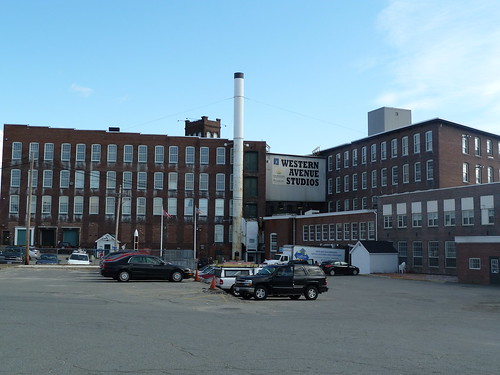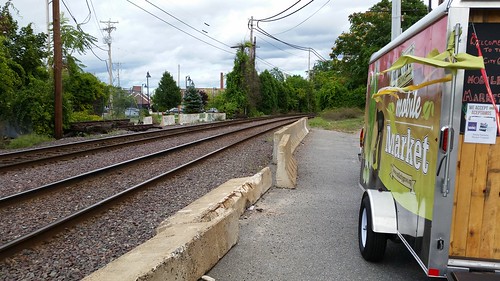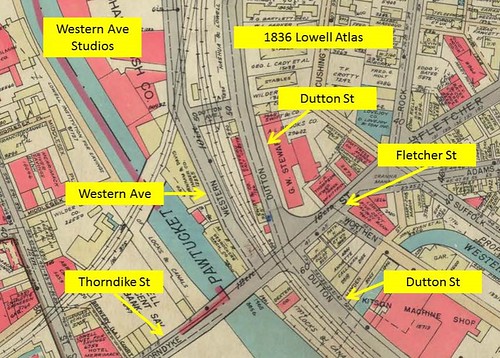Western Ave and Thorndike Street: Some History

Western Avenue Studios
Western Avenue Studios is a small business incubator for Lowell and is said to be the biggest collection of artists in one location east of the Mississippi River. Located in the former Massachusetts Mohair Plush mill building alongside the Pawtucket Canal, Western Avenue Studios is just a short walk from the Hamilton Canal District and the rest of downtown Lowell – except it isn’t, because that end of Western Ave is blocked to both vehicular and pedestrian traffic.

The end of Western Ave with Dunkin Donuts and Mill No. 5 visible beyond railroad tracks

1936 Lowell Atlas showing intersection of Western Ave and Thorndike St
In the early 1900s, Western Avenue connected School Street to Thorndike Street, as shown in the image from the 1936 Lowell Atlas shown above. Back then, Fletcher and Thorndike Streets ran in a straight line, connecting at their intersection with Dutton Street, which ran along the Merrimack Canal from French Street, through Fletcher/Thorndike, and on to Willie Street in the Acre. Western Ave ran parallel to Dutton Street and intersected Thorndike a short distance to the south of Dutton, about where the drive through lane for the Dunkin Donuts is now located. At some point (I don’t yet know when or why) Western Ave was blocked at its Thorndike Street end.

School Street bridge at Western Ave
Western Ave remained blocked until 1985. That year, a devastating fire destroyed the School Street bridge over the Pawtucket Canal in the vicinity of the gas company (it was a large gas line that ran under the bridge that ruptured and made the fire so intense). To help alleviate the traffic disruption caused by the closure of School Street, the Lowell City Council on November 19, 1985, petitioned the Middlesex County Commissioners for permission to establish “a highway-rail grade crossing” at Western Avenue. The purpose of this crossing was “to provide a temporary detour route for vehicular traffic during the reconstruction of the School Street bridge which was partially destroyed by fire.” After a public hearing on this petition, the Department of Public Utilities ruled that the request was reasonable and recommended the County Commissioners grant the request with the conditions that permission for the crossing would end in five years or upon completion of the re-opening of the School Street bridge and on the further condition that the city pay for an automatic protection system of gates, bells, and flashing lights at the crossing for as long as it was allowed.

Photo from July 17, 1995 Lowell Sun. Reopening of School Street Bridge
The new School Street bridge took ten years to complete, reopening on July 17, 1995, but not everyone wanted Western Avenue to be again closed at Thorndike Street. Since the fire, Ed Souza, an employee of the city’s Department of Planning and Development, had built Mill City Car Wash at the end of Western Avenue on the site now occupied by the Dunkin Donuts. Sousa argued to a city council subcommittee that closing that end of Western Ave would hurt his business. Supporting Sousa’s request were City Councilor Tarsy Poulios and then-State Representative Steve Panagiotakos.
Opposing the request to keep Western Avenue open was Elkin McCallum, president of Joan Fabrics, which had a manufacturing plant on Western Ave (presumably in the building now occupied by Western Avenue Studios). The Lowell Sun political column on June 4, 1995, “Storm Brews over planned closure of Western Ave,” quoted a letter to the city from McCallum as saying “Opening Western Avenue at both ends would seriously impact [his company’s] expansion plans” on Western Avenue.” The column speculated that since McCallum had just moved his corporate headquarters from Lowell to Tyngsboro, so City Manager Richard Johnson would not want to be seen as disregarding McCallum’s concerns about his Western Avenue facility. The article stated the many large trucks that serviced McCallum’s facility would have an easier time maneuvering if Western Ave was again a dead-end street. (An additional consideration for city leaders may have been Mr. McCallum’s status as one of the three co-owners of the American Hockey League franchise that was coming to the city the following year to play in the as yet unfinished Tsongas Arena).
Western Avenue was re-closed at Thorndike Street shortly thereafter and it has stayed closed ever since. The community can probably live with it remaining closed to vehicular traffic. But it is essential to the continued and future economic vitality of Western Avenue Studios and to the Hamilton Canal District and, by extension, the rest of downtown, that it be reopened legally and safely to pedestrians, and not with some hyper-expensive bridge that no one will want to use, but with an at-grade pedestrian crossing with lights, bells, and gates. Lowell city government was able to reopen the road back in 1985 when circumstances demanded it. We should be able to do it again.

2016 Google imagery of Western Ave – Thorndike St area.
Excellent article on the history! As a Western Ave artist AND a Downtown resident I would love to see this happen. A safe passage between the two would be a huge benefit to both communities!
The railroad frequently leaves empty freight cars parked on the tracks at the end of Western Avenue. There is often one or two train engines idling for hours on the track blocking the roadway. An at ground level pedestrian crossing would be a huge improvement to this area, however there will have to be some work done by the city to find a way to work around the railroad.
Thanks for the very informative article. I fully support the reopening of Western Avenue Studios
Starting in the late 1980’s, Elkin McCallum was chair and CEO of Joan Fabrics, which was housed in the buildings now known as Western Avenue Studios. I have also recently met and talked with him about the building, so I can confirm this info.
First I want to bring to your attention that one takes one’s life in their own hands trying ti cross Dutton St. from the Point Park area. I have had many a close call.I don’t drive. If I want to go to Western Ave. studios for an event or classes I have to walk over the railroad tracks to get there. There are homeless persons living along the tracks and it feels unsafe trying to maneuver the the tracks and the general area at night when most gallery receptions and many events are held.Often I encounter a train parked on the tracks when I reach the area seen in the photo above. This requires walking down the tracks for the length of the train until there is an opening to pass through to the other side.All the while hoping it is not going to start up and not see me there.Usually the engine is running. If the train is very long one has no other option than climb over the apparatus that connects the trains. This is dirty,dangerous and,really,outrageous. Then there is the winter snow that is piled very high in the area shown in the photo,blocking the entrance altogether. If I really need to get there,for a class or whatever reason, I must scale the snowbank,then walk the tracks. If there is a train in the way as well,then I turn around,go back home and miss my class or event because I know I will have to do the same steps on the way back in a few hours. Not worth the effort. Western Ave. is a huge part of our community yet there is no public transportation to the site. I have voiced my concern with the claim that the art community is so walkable in the past. But it is so disconnected that it is not. There must be a concerted effort made to make Western Ave more accessible to pedestrians and tourists on foot. As it is now it is exclusionary.I am by no means the only one who has had to deal with this oversight for years. I wish more would join me and speak out on the issue
.
One would think the city of Lowell would zealously welcome connecting Western Avenue Studio to downtown. It boasts it’s commitment to cultural endeavors and communities. It makes no sense at all to keep this thriving, creative and industrious community essentially closed to the public. Society at large needs to cherish it’s artists and individuals need encouragement delve into their own creative talents. Let us embrace the arts! Let us embrace creativity!